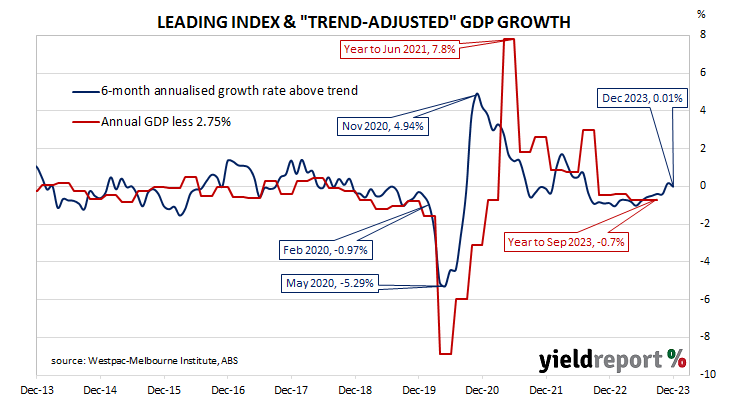Summary: Leading index growth rate down in December; index growth continues to show clear improvement; reading implies annual GDP growth of around 2.75%; ACGB yields rise moderately; rate-cut expectations soften slightly; stabilisation rather than cyclical upturn.
Westpac and the Melbourne Institute describe their Leading Index as a composite measure which attempts to estimate the likely pace of Australian economic growth in the short-term. After reaching a peak in early 2018, the index trended lower through 2018 and 2019 before plunging to recessionary levels in the second quarter of 2020. Subsequent readings spiked towards the end of 2020 but then trended lower through 2021 and 2022 before flattening out in first half of 2023.
The December reading of the six month annualised growth rate of the indicator registered 0.01%, down from November’s revised figure of +0.18%.
“Despite the dip back into year-end, the Leading Index growth continues to show a clear improvement,” said Westpac senior economist Matthew Hassan. “December is the second consecutive month that the Index growth rate has been around or slightly above the zero ‘gain line’.”
Index figures represent rates relative to “trend” GDP growth, which is generally thought to be around 2.75% per annum in Australia. The index is said to lead GDP by “three to nine months into the future” but the highest correlation between the index and actual GDP figures occurs with a three-month lead. The current reading is thus indicative of an annual GDP growth rate of around 2.75% in the next quarter.
Domestic Treasury bond yields rose moderately on the day. By the close of business, the 3-year ACGB yield had added 2bps to 3.789% while 10-year and 20-year yields both finished 4bpos higher at 4.25% and 4.55% respectively.
In the cash futures market, expectations regarding rate cuts later this year softened slightly. At the end of the day, contracts implied the cash rate would remain close to the current rate for the next few months and average 4.32% through February, 4.315% in March and 4.30% in April. However, August contracts implied a 4.165% average cash rate while November contracts implied 4.005%, 31bps less than the current rate.
“However, the broad picture still looks to be of, at best, a stabilisation rather than the beginning of a cyclical upturn,” Hassan added. “Much of the lift is coming from a recovery in commodity prices since mid-2023, a rally that may not last. Meanwhile momentum excluding this component still looks to be weak.”


